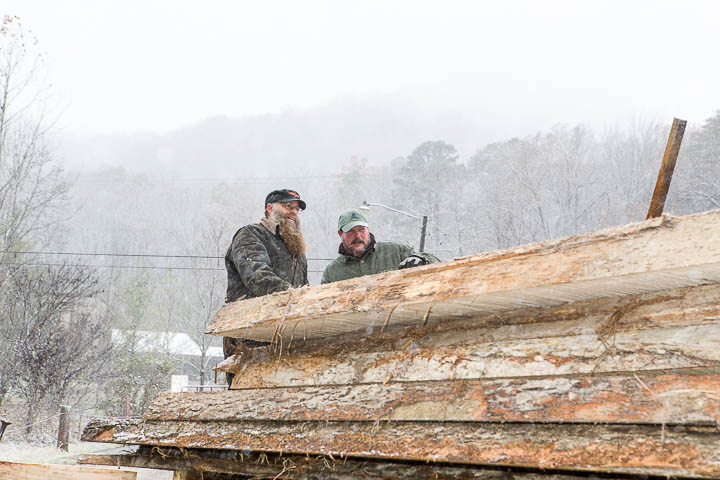Kentucky wood bound for Plimoth Plantation and history
Kentucky wood bound for Plimoth Plantation and history

It was a fitting sight on a cold, snowy day close to Thanksgiving. A tractor-trailer laden with 30-foot planks of freshly sawn white oak began the final leg of a journey from the Bluegrass to Plymouth, Massachusetts, destined for the refitting of the Mayflower II.
The original Mayflower that carried a sea-weary group of Pilgrims to New England and into American folklore is long gone, but her historical reproduction, Mayflower II, carries her own historical significance. The United Kingdom presented the ship to the U.S. in 1957 commemorating America’s help during World War II. Since then, the ship has hosted millions of school children and tourists at its mooring at the Smithsonian-affiliated living history museum, Plimoth Plantation.
When the Mayflower II went into dry dock in 2012 for her annual Coast Guard inspection, the scuttlebutt around Plymouth, Massachusetts, was that the shipwrights would need some extraordinary white oak timber to repair about a dozen futtocks and 60 long planks in her hull.
What’s a futtock? University of Kentucky College of Agriculture, Food and Environment forestry extension professor Terry Conners knew—they’re curved timbers that make up the hull’s framework—and he also knew the wood needed isn’t available at lumberyards. The native New Englander thought, with his contacts in the wood industry, he could help locate the timber. He immediately offered his landlubber expertise.
Conners had quite a task ahead. The planks had to be 26- to 32-feet long and 3.5-inches thick, with a minimum of 10-inch wide heartwood along the length. This meant looking for some very big trees. To complicate matters, they had to be practically defect-free.
“It’s very hard to source white oak that we need in the lengths we need, the thicknesses we need and the high quality we need to be able to cut the sweep of the planks out,” said Whit Perry, associate director for maritime preservation and operations for the Mayflower II at Plimoth Plantation. Perry was on hand when the boards were loaded onto the flatbed truck. “It would be easy to go out and buy some other type of wood, tropical hardwood or something along those lines, but at the museum we’re of the mind that we want to restore Mayflower II in the same way it was built in 1957.”
Conners turned his sights on UK’s Robinson Forest, but Robinson was clear-cut in the 1920s.
“We don’t have the diameter or the quality timber that this particular project requires,” he said. He located a sawyer in Georgia who could supply some of the portside planking, but he really wanted some of the timber to be Kentucky-grown.
Conners turned toward the Berea College Forest, whose forester, Clint Patterson, is a UK forestry graduate student.
“There’s good synergy between UK and Berea,” Patterson said. “Berea College allows UK to utilize our forest for research purposes, field days and student training.”
It turned out Berea College had what Conners was looking for. Patterson tagged a few trees with potential.
When master logger Holger Grossler, from Louisville, heard Conners was looking for such long boards, he said his first reaction was it was impossible.
“I was trained that at 16 or 18 feet white oak usually stops being clean,” he said, meaning the wood would start showing defects at that point. “But Clint is a good forester with a good eye to spot those trees. When I saw the first one he spotted, I thought wow, that’s a really exceptional one, and it turned out to be good.”
A successful test cutting was done in March. When the lumber from that tree passed muster, 10 more trees were cut and sawn on site this past summer.
Almost twice the normal length of sawn lumber, trees that can provide 30-foot planks are difficult to move and saw. Grossler’s team cut down the oaks and arranged to have Ernie Tebeau from Toledo, Ohio, bring down his portable saw mill to saw the trees into suitable lengths and widths. Then the planks were hauled out to the nearest road to be loaded onto the flatbed.
As the four men stood in the blowing snow and watched the truck pull away with 30 planks destined to be part of American history, there was definitely a feeling of celebration in the air. It had been almost a yearlong journey to that point, but Conners felt it was just the beginning of what he hoped would be a bright future for the whole state.
“I’m trying to spread the word that we have reason to manage timber not just for the 100 or 200 years we normally do, but for 300 years,” he said. “This is good for the industry, as well as for Berea, as well as it is for Kentucky.”
Forestry

